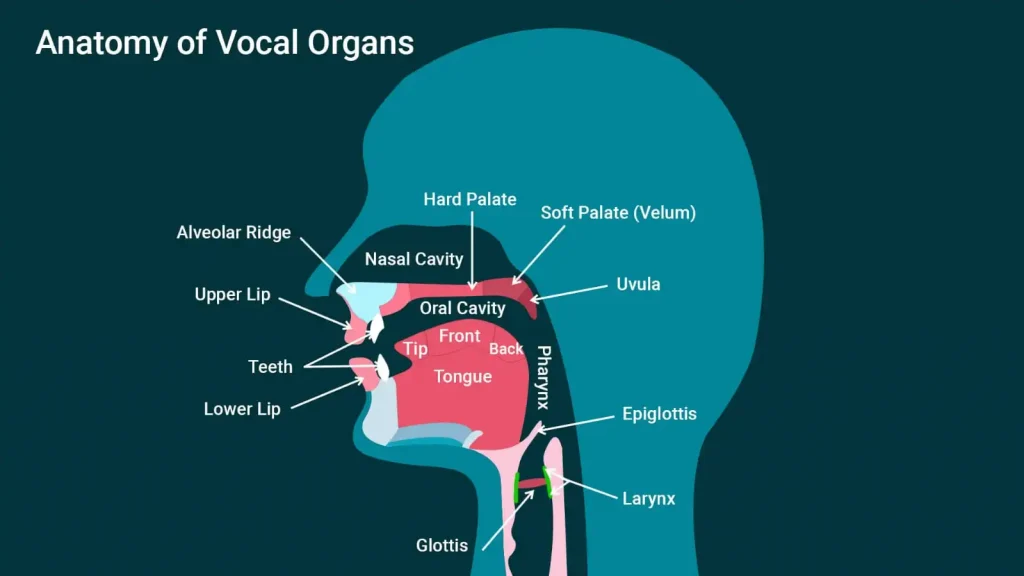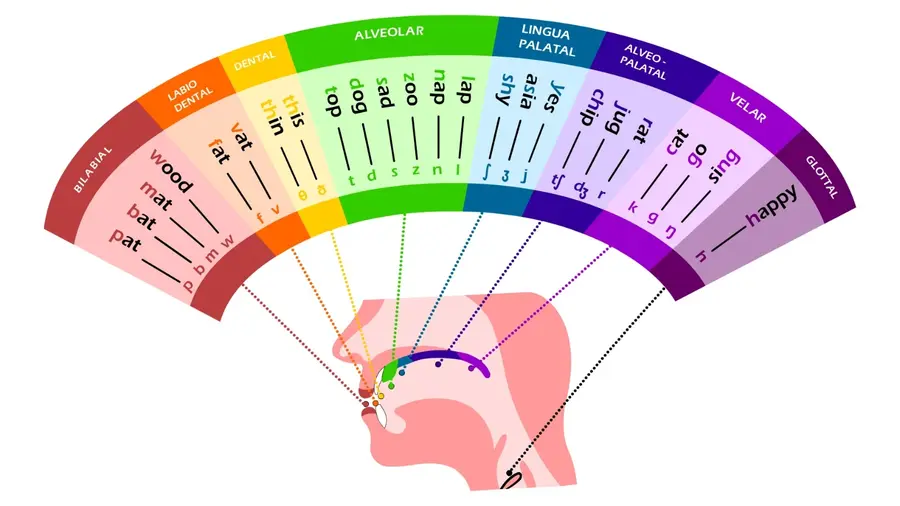Speak Like a Pro: Mastering Sounds with Articulation Places
By Rajini D
Last Updated: February 23, 2024
Speech is a fascinating and complex aspect of human communication intricately woven into the fabric of our daily interactions. It involves a variety of sounds, each distinct and essential for conveying meaning. The classification of these speech sounds, especially based on their place of articulation, is a fundamental concept in both language learning and the field of linguistics.
Understanding where and how these sounds are produced in the vocal tract not only enriches our knowledge of language structures but also aids in language learning, speech therapy, and phonetic studies. For linguists, this classification is crucial for analyzing phonetic variations across languages, while language learners can benefit from this knowledge to improve pronunciation and comprehension. In essence, the study of speech sounds and their places of articulation is a window into the diverse and dynamic world of human language.
Struggling with communication? Book Free Speech Therapy Consultation.
The Basics of Speech Sounds

Defining ‘Place of Articulation’
At the heart of speech sound production is the concept of ‘place of articulation.’ This term refers to the specific part of the vocal tract where airflow is restricted or altered to produce different sounds. The vocal tract consists of various anatomical structures, including the lips, teeth, tongue, alveolar ridge, hard and soft palate, and glottis. By manipulating these structures, we can create a wide range of sounds, each unique to certain languages and dialects.
For more information on speech and language milestones, check out our detailed guide.
How Speech Sounds are Produced

The production of speech sounds is a coordinated effort involving various parts of the vocal tract. When we speak, air from the lungs is pushed out and its flow is shaped by the tongue, lips, and other parts of the mouth and throat. Depending on where this airflow is constricted or modified, different sounds emerge. These sounds are broadly categorized into vowels and consonants, with consonants further classified based on the place of articulation.
For example, when the airflow is obstructed by both lips (a bilabial articulation), it produces sounds like /b/ and /p/. If the tongue touches the teeth (dental articulation), we get sounds like /θ/ in “think.” The complexity and variety of these sounds form the foundation of spoken language, enabling us to communicate a vast array of emotions, intentions, and information.
Classification Speech Sounds
| Type of sounds | Description | Examples |
|---|---|---|
| Bilabial sounds | Produced by bringing both lips together | /p/ (as in “pat”) – voiceless stop plosive /b/ (as in “bat”) – voiced stop plosive /m/ (as in “mat”) – voiced nasal /w/ (as in “water”) – voiced glide |
| Labiodental sounds | Produced by touching the bottom lip to the upper teeth | /f/ (as in “fat”) – voiceless fricative /v/ (as in “vat”) – voiced fricative |
| Lingua dental sounds | Produced by placing the tongue against the upper teeth | /θ/ (as in “thin”) – voiceless fricative /ð/ (as in “this”) – voiced fricative |
| Lingua alveolar sounds | Produced by placing the tongue against or close to the alveolar ridge behind the upper front teeth | /t/ (as in “top”) – voiceless stop plosive /d/ (as in “dog”) – voiced stop plosive /s/ (as in “sat”) – voiceless fricative /z/ (as in “zoo”) – voiced fricative /n/ (as in “nap”) – voiced nasal /l/ (as in “lap”) – voiced lateral |
| Lingua-palatal sounds | Produced by raising the front part of the tongue to the hard palate | /ʃ/ (as in “shy”) – voiceless fricative /ʒ/ (as in “measure”) – voiced fricative /j/ (as in “yes”) – voiced glide |
Alveo-palatal sounds | Produced by a complex tongue movement from the alveolar ridge to the hard palate | /tʃ/ (as in “chip”) – voiceless affricate /dʒ/ (as in “jug”) – voiced affricate /r/ ( as in rat) – voice glide |
| Lingua velar sounds | Produced by raising the back of the tongue towards the velum or soft palate | /k/ (as in “cat”) – voiceless stop plosive /g/ (as in “go”) – voiced stop plosive /ŋ/ (as in “sing”) – voiced nasal |
| Glottal sounds | Produced using the glottis; airflow is manipulated at the vocal cords | /h/ (as in “hat”) – voiceless fricative |
Also Read: Home-Based Occupational Therapy Activities.
Bilabial Sounds
Exploring Bilabial Articulation
Bilabial sounds are a fundamental aspect of human speech, characterized by the use of both lips in their articulation. These sounds are produced when the airflow is obstructed by the closure or near-closure of the lips. This category includes some of the first sounds made by infants, highlighting their natural and intuitive place in language development.
In linguistic terms, bilabial sounds are versatile, occurring in numerous languages worldwide. They include both voiced and voiceless consonants, depending on whether the vocal cords vibrate during the articulation.
Discover more about what to expect in speech and language development at these ages by reading about 2 to 3-year milestones and 3 to 4-year milestones.
Examples of Bilabial Sounds
Bilabial consonants are prevalent in everyday language and include sounds such as:
- /p/ as in “pat”: This is a voiceless bilabial plosive, where the sound is produced by releasing a burst of air after the lips part.
- /b/ as in “bat”: A voiced counterpart to /p/, /b/ involves the vibration of the vocal cords while the lips briefly close and then open.
- /m/ as in “mat”: This is a bilabial nasal, where the air escapes through the nose while the lips are closed, and it is voiced.
These sounds illustrate the varied use of bilabial articulation in language, demonstrating its importance in speech.
If your child is on the autism spectrum and experiencing speech delays or atypical phonological processes, learn about our Speech Therapy for Autism.
Articulation Places and Language Examples
| Place of Articulation | Language Examples |
|---|---|
| Bilabial | English, Spanish, Mandarin, Hindi |
| Labiodental | English, German, Spanish, Russian |
| Dental | English (in some dialects), Spanish, Arabic, Thai |
| Alveolar | English, Spanish, Russian, Japanese |
| Lingua-Palatal | English, French, Mandarin, Russian |
| Alveo-Palatal | English (in some dialects), Polish, Mandarin, Italian |
| Velar | English, German, Spanish, Korean |
| Glottal | Arabic, Hebrew, Hawaiian, Cockney English |
Labiodental Sounds
Understanding Labiodental Articulation
Labiodental sounds are articulated with the involvement of both the lower lip and the upper front teeth. This type of articulation is characterized by the lower lip making contact with the upper teeth, creating a distinctive sound quality. These sounds are common across many languages and are essential for clarity in speech.
Labiodental sounds offer a contrast to bilabial sounds, as they involve a different part of the mouth, demonstrating the diversity in how humans produce speech sounds.
Learn more about Autism Spectrum Disorder and its therapies.
Examples of Labiodental Sounds
Common labiodental consonants include:
- /f/ as in “fat”: This is a voiceless labiodental fricative produced by forcing air through the narrow gap between the lower lip and upper teeth, creating friction.
- /v/ as in “vat”: The voiced counterpart to /f/, /v/ involves the same positioning but with the addition of vocal cord vibration.
These sounds are essential in many languages for differentiating words and conveying precise meanings.
Discover the benefits and features of our online speech therapy services.
Dental Sounds
The Nature of Dental Sounds
Dental sounds are a distinctive group of consonants produced by the tongue making contact with the upper teeth. These sounds are termed “dental” due to this direct involvement of the teeth in their articulation. The precise nature of this contact – whether the tongue touches the teeth directly or is positioned close to them – can create subtle variations in sound.
In many languages, dental sounds contribute significantly to phonetic richness and are crucial for clear communication. They often serve to distinguish words that would otherwise sound identical.
For insights into how online speech therapy can support your toddler’s development, visit our article on Understanding Online Speech Therapy for Toddlers.
Examples of Dental Sounds
Some common dental consonants include:
- /θ/ as in “thin”: This is a voiceless dental fricative, created by the tongue lightly touching the upper front teeth and air passing through the gap, producing a soft hissing sound.
- /ð/ as in “this”: The voiced counterpart to /θ/, /ð/ is produced similarly but with the addition of vocal cord vibration.
These examples illustrate how dental sounds are integral to many languages, adding nuance and precision to speech.
Read about the innovative online speech therapy redefined with Tele-Basics.
Alveolar Sounds
Exploring Alveolar Articulation
Alveolar sounds are among the most common consonants in many languages. These sounds are produced by the tongue making contact with or coming close to, the alveolar ridge – the small ridge located just behind the upper front teeth. The variety and frequency of alveolar sounds in languages worldwide highlight their importance in human speech.
Interested in the top online speech therapy websites? Find out more here.
Examples of Alveolar Sounds
Key alveolar consonants include:
- /t/ as in “top”: This is a voiceless alveolar stop, where the sound is produced by the tongue briefly blocking airflow at the alveolar ridge and then releasing it.
- /d/ as in “dog”: The voiced counterpart to /t/, /d/ involves similar tongue placement but with vocal cord vibration.
- /s/ as in “sat”: A voiceless alveolar fricative produced by positioning the tongue close to the alveolar ridge, creating a narrow channel through which air passes with a hissing sound.
- /z/ as in “zoo”: The voiced version of /s/, where the tongue and alveolar ridge positioning are the same, but with vocal cord vibration.
- /n/ as in “nap”: An alveolar nasal sound made with the tongue pressed against the alveolar ridge while air passes through the nose.
- /l/ as in “lap”: Known as an alveolar lateral approximant, it is produced by allowing air to flow around the sides of the tongue while it touches the alveolar ridge.
These sounds demonstrate the diversity and utility of alveolar articulation in forming words and conveying meaning.
Lingua-Palatal Sounds
Understanding Lingua-Palatal Articulation
Lingua-palatal sounds, commonly known as palatal sounds, are produced by the front part of the tongue coming into contact with or approaching the hard palate. This area is the bony part of the roof of the mouth, located towards the front, just behind the alveolar ridge. The distinctive feature of these sounds lies in their ‘palatal’ quality, where the tongue’s movement towards the hard palate plays a crucial role in sound production.
Palatal sounds are prevalent in many languages and add a rich layer of phonetic diversity to speech.
Examples of Lingua-Palatal Sounds
Key examples of lingua-palatal consonants include:
- /ʃ/ as in “shy”: This is a voiceless lingua-palatal fricative. It is produced by positioning the front part of the tongue close to the hard palate, creating a narrow channel for air to pass through, resulting in a characteristic hissing sound.
- /ʒ/ as in “measure”: A voiced counterpart to /ʃ/, /ʒ/ involves similar tongue placement but with vocal cord vibration.
- /j/ as in “yes”: This sound is a voiced palatal approximant, where the front part of the tongue is raised towards the hard palate but not as close as in /ʃ/ or /ʒ/, allowing the vocalized air to pass through more freely.
These examples underscore the importance of precise tongue and palate coordination in producing distinct lingua-palatal sounds.
Alveo-Palatal Sounds
The Nature of Alveo-Palatal Sounds
Alveo-palatal sounds, also known as post-alveolar sounds, are articulated by the tongue making contact with or moving towards the area between the alveolar ridge and the hard palate. These sounds represent a blend of alveolar and palatal articulations, creating unique and distinct consonants in speech.
These sounds are integral to many languages and offer a fascinating insight into the versatility of human speech production.
Examples of Alveo-Palatal Sounds
Common alveo-palatal consonants include:
- /tʃ/ as in “chip”: This is a voiceless alveo-palatal affricate. The sound begins with the tongue at the alveolar ridge (similar to /t/) and then moves into a position close to the hard palate (resembling /ʃ/), creating a distinct stop-and-fricative combination.
- /dʒ/ as in “jug”: The voiced counterpart to /tʃ/, /dʒ/ involves a similar articulation pattern but includes vocal cord vibration.
- /r/ as in “rat”: This sound varies among languages; often, it is a voiced alveolar or post-alveolar trill or tap. The tongue is positioned near the alveolar ridge and may lightly touch the palate, creating a rolling or flapping sound.
These examples highlight the dynamic nature of alveo-palatal articulation in human speech.
Velar Sounds
Exploring Velar Articulation
Velar sounds are a distinctive set of consonants produced using the back part of the tongue against the velum or the soft palate, the soft area towards the back of the roof of the mouth. These sounds are integral to numerous languages and contribute significantly to the diversity of human speech.
The production of velar sounds involves a specific positioning of the tongue, which, depending on whether the sound is voiced or voiceless, can create a variety of tones and resonances.
Examples of Velar Sounds
Common velar consonants found in various languages include:
- /k/ as in “cat”: A voiceless velar plosive, where the sound is created by momentarily stopping the airflow with the back of the tongue against the soft palate and then releasing it.
- /g/ as in “go”: The voiced counterpart to /k/, /g/ involves a similar tongue placement but with the addition of vocal cord vibration.
- /ŋ/ as in “sing”: This is a voiced velar nasal, where the back of the tongue closes against the soft palate, and the air resonates in the nasal cavity.
These examples demonstrate the wide use and importance of velar sounds in various languages.
Glottal Sounds
The Nature of Glottal Sounds
Glottal sounds are produced using the glottis, the space between the vocal cords in the larynx. Unlike other consonants that involve the tongue, teeth, or other parts of the mouth, glottal sounds are unique for their reliance on the vocal cords and the glottal space. They add a distinct element to speech, often used for subtle yet important phonetic distinctions.
Examples of Glottal Sounds
Typical glottal sounds include:
- /h/ as in “hat”: This is a voiceless glottal fricative created by the airflow passing through the open glottis, producing a gentle, breathy sound.
- The glottal stop, often represented by a symbol like ʔ, occurs in many languages and dialects. It’s not always represented in writing but is a significant sound in speech. An example is the catch in the throat, often heard in the middle of “uh-oh.”
These sounds, while sometimes less prominent than others, play a crucial role in the phonetic makeup of many languages.
Comparison of Speech Sound Categories
| Sound Category | Place of Articulation | Voiced/Voiceless | Examples |
|---|---|---|---|
| Bilabial | Both Lips | Both | /b/ (bat), /p/ (pat), /m/ (mat) |
| Labiodental | Lower Lip and Upper Teeth | Both | /f/ (fat), /v/ (vat) |
| Dental | Tongue and Upper Teeth | Both | /θ/ (thin), /ð/ (this) |
| Alveolar | Tongue and Alveolar Ridge | Both | /t/ (top), /d/ (dog), /s/ (sat), /z/ (zoo), /n/ (nap), /l/ (lap) |
| Lingua-Palatal | Front of Tongue and Hard Palate | Mostly Voiced | /ʃ/ (shy), /ʒ/ (measure), /j/ (yes) |
| Alveo-Palatal | Tongue, Alveolar Ridge to Palate | Mostly Voiced | /tʃ/ (chip), /dʒ/ (jug), /r/ (rat) |
| Velar | Back of Tongue and Soft Palate | Both | /k/ (cat), /g/ (go), /ŋ/ (sing) |
| Glottal | Glottis (Vocal Cords) | Mostly Voiceless | /h/ (hat), Glottal stop (middle of ‘uh-oh’) |
Conclusion
The Importance of Understanding Articulation Places in Speech Sounds
This exploration of speech sounds and their places of articulation underscores the complexity and diversity of human language. Each category of sound, from bilabial to glottal, contributes uniquely to the tapestry of speech, enabling us to convey a wide array of meanings and emotions.
Understanding these articulation places is not only fascinating from a linguistic standpoint but also crucial for language learners, speech therapists, and anyone interested in the nuances of human communication. By appreciating these different sounds, we can deepen our understanding of language structures and enhance our ability to learn and teach languages effectively.
I encourage readers to explore these sounds in various languages, appreciating the rich diversity and intricate mechanics of speech. This journey through the world of phonetics is not just an academic pursuit but a pathway to connecting more deeply with the myriad ways we express ourselves through language.
Frequently Asked Questions:
1. What are Speech Sounds and How are They Classified?
Speech sounds are the basic elements of spoken language, classified based on how and where they are produced in the mouth. This classification includes bilabial, labiodental, dental, alveolar, lingua-palatal, alveo-palatal, velar, and glottal sounds, each defined by their unique place of articulation.
2. Why is the Place of Articulation Important in Speech Sounds?
The place of articulation is crucial as it determines the distinct sound characteristics in speech. Understanding these articulation places helps in language learning, speech therapy, and linguistics, aiding in clear pronunciation and comprehension of different languages.
3. What are Bilabial Sounds and How are They Produced?
Bilabial sounds are produced by using both lips, like /b/ in “bat” or /p/ in “pat”. They involve the closure or near-closure of the lips and are fundamental in many languages.
4. How Do Labiodental and Dental Sounds Differ?
Labiodental sounds involve the lower lip and upper teeth, like /f/ in “fat”, while dental sounds are produced by the tongue against the upper teeth, like /θ/ in “thin”. These articulations result in distinctly different speech sounds.
5. What Makes Alveolar Sounds Unique?
Alveolar sounds are produced with the tongue against or close to the alveolar ridge, just behind the upper front teeth. Examples include /t/ in “top” and /d/ in “dog”. They are prevalent in many languages and crucial for verbal communication.
6. Can You Explain Lingua-Palatal and Alveo-Palatal Sounds?
Lingua-palatal sounds are made with the front part of the tongue against the hard palate, like /ʃ/ in “shy.” Alveo-palatal sounds involve the tongue moving from the alveolar ridge toward the hard palate, like /tʃ/ in “chip.”
7. What are Velar and Glottal Sounds?
Velar sounds are produced with the back part of the tongue against the soft palate, such as /k/ in “cat.” Glottal sounds are formed using the glottis, like the /h/ sound in “hat.” These sounds add depth and variety to speech.
8. How Can Understanding Speech Sounds Benefit Language Learners?
Language learners can greatly benefit from understanding speech sounds as it aids in mastering pronunciation, reducing accents, and improving overall communication skills in a new language.
9. Are There Any Speech Sounds Unique to Certain Languages?
Yes, some speech sounds are unique to specific languages or dialects, contributing to the rich diversity of global languages. These unique sounds often pose interesting challenges for language learners.
About the Author:
M.Sc., Speech-Language Pathologist (9+ years of experience)
Rajini is a passionate and dedicated Speech-Language Pathologist with over 9+ years of experience, specializing in both developmental speech and language disorders in children and rehabilitation in adults. Driven by a desire to empower each individual to find their voice, Rajini brings a wealth of experience and a warm, genuine approach to therapy.
Currently, at Wellness Hub, she thrives in a team environment that values innovation, compassion, and achieving results for their clients.
Connect with Rajini to learn more about how she can help you or your loved one find their voice.
Book your Free Consultation Today
Parent/Caregiver Info:
Client’s Details:
* Error Message









